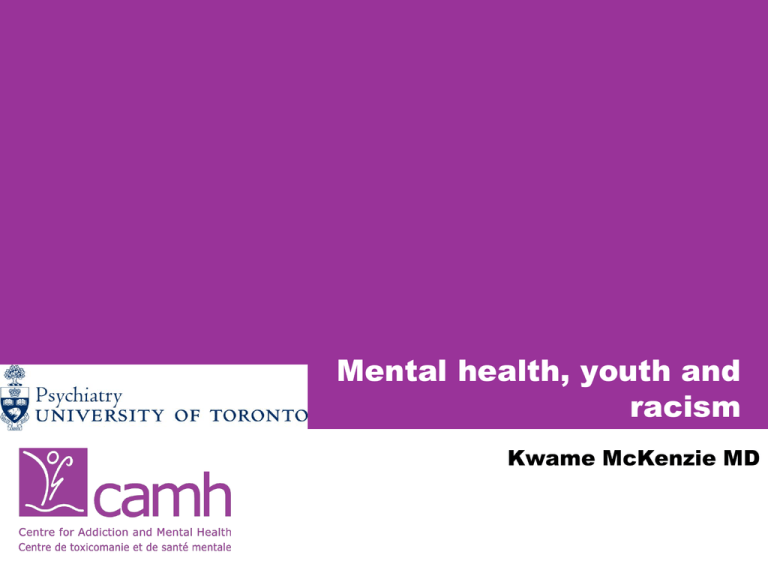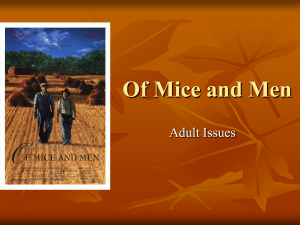
Mental health, youth and
racism
Kwame McKenzie MD
Mental capital the new frontier
If we are to prosper and
thrive in our changing
society and in an
increasingly
interconnected and
competitive world, both
our mental and material
resources will be vital.
Encouraging and enabling
everyone to realise their
potential throughout their
lives will be crucial for our
future prosperity and
wellbeing.
2
Mental capital = IQ + EQ + mental health
EQ = social skills
Emotional intelligence (EQ) is not a new concept;
Around since Socrates: “ Know Thyself”.
Studies show that EQ is the best predictor of a child's future
achievement; better than any other single factor.
EQ is a better predictor of success than IQ and technical skills
combined
Robin Stern NYU
4
Mental illness is costly
4 of the top 10 leading causes of
disability
30% of disability claims and 70% of the
total costs
estimated cost of mental illness to the
Canadian economy is $51 billion
At least 50% starts before age of 14
5
Mental illness prevention
Evidence based, costeffective strategies
documented
Ontario legislature
concluded for every
$1 spent on mental
health promotion you
get $7 return
But we do not do this
very well.
6
Mental health in IRER groups
Canadian literature tagcloud
7
Rates
8
Clusters of research
Rates
Social determinants
Barriers and facilitators of care
9
Canadian-Born Population and Immigrants
Reporting "Fair" or "Poor" Health,
Source: Newbold KB. Self-rated health within the Canadian immigrant population: Risk and the healthy immigrant effect. Social Science and Medicine, 2005.16
10
More likely to develop poor health
if you are non-European
* Significantly different from estimate for Canadian-born (p <0.01).
Note: All explanatory variables are based on the situation in 1994/95. Because of rounding, some confidence intervals with 1.0 as upper/lower limit are significant.
Data source: 1994/95 to 2002/03 National Population Health Survey, longitudinal file.
11
2011 schools data CAMH
12
Ontario Schools
Social determinants
14
15
16
The problem is not just Bay Street
17
% immigrant population by electoral ward
In Toronto
18
Ratio of earnings of recent immigrants to
Canadian people is decreasing over time
1
0.9
0.8
0.7
0.6
0.5
0.4
0.3
0.2
0.1
0
1980
Males w Univ. Deg
1990
Females w Univ. Deg
2000
Males w/o Univ. Deg
2005
Females w/o Univ. Deg
19
City1
City2 City3
Most children in Toronto
live in City 3
1/3 of people in City 3
live under low income
cut off
50% of the housing for
families in City 3 is high
rise
Poverty is color coded
20
A problem in the future?
City 3 is high poverty and high immigrant
Our population growth is due to people in City 3
If we are going to move forward and be competitive
we need to invest in City 3
Parents doing a good job buffering children from
problems
But what happens if we want to move forwards and
integrate economies so that children can get access
to resources and help build our future?
21
Racism
Recorded racially aggravated crime
England and Wales (data Home Office)
25000
20000
15000
10000
5000
0
1999/00
2000/1
Property crime
2001/2
2002/3
2003/4
2004/5
Assault and wounding
Harrassment
23
Hate crimes in Canada in 2006
24
Models of pathways to
health impact of racism
Pathways to racism’s health impact
Socially inflicted trauma
• mental, physical, or sexual
Economic and social inequality
• Decreased mobility due to racism (education,
employment)
Inadequate, inappropriate or degrading
medical care
Targeted marketing of commodities and
lifestyles that can harm health: alcohol,
tobacco, drugs
26
US Surgeon general report mental
health pathways
Internalization of racial stereotypes & negative images
which denigrate individuals’ self-worth and adversely
affecting their social and psychological functioning;
Institutional racism resulting in stressors that can affect
mental health due to living conditions, crime, violence,
poverty …
27
Racism effects –
getting under the skin
Acute stressor (life events)
Chronic stressor (micro-aggression)
Body:
•
•
•
•
•
adreno-corticoids
t-cell change
early aging
weathering
foetal growth
Cognitive development
• Long term change in cognitive focus eg / increased vigilance
Personality/ identity
• (resilience/ vulnerability)
28
Racism stress is different
3 stage model:
1) Stress because of life event
2) Stress because life event
considered unfair
3) Stress because of inability to do
anything about it
29
Pascoe and Richman
30
Pascoe and Richman
Links between racism and health occur through the
mechanisms of stress responses and health
behaviors.
Our synthesis of existing literature also suggests that
social support, active coping styles, and group
identification were most likely to serve a protective
function in these pathways.
31
Racism and schizophrenia
Stress of Migration increases risk of
schizophrenia. Cantor Graae and Selten 2005
33
Genetics
34
Stress and daily hassles
35
Stress
Increased rates of schizophrenia if you:
• live in neighborhoods that are stressful
• have numerous daily hassles
36
Racism psychosis risk factor cross
sectional
Odds of suffering from a psychosis:
• Verbal abuse victims
–
2.86 (1.69-4.83)
• Racist attack victims
–
4.77 (2.32-9.80)
• Thinking most employers racist
–
1.57 (1.02-2.42)
• Karlsenn & Nazroo Am J Public Health. 2002
37
Racism psychosis risk factor – cross
sectional
Estimated prevalence of psychosis
All Ethnic Minority Groups
4.0%
3.0%
2.0%
1.0%
0.0%
No
Verbal
only*
Physical*
Racial harassment
No
Some
Most*
British employers discriminate
Karlsenn et al Psychological Medicine 2005
38
Racism ecological risk factor for
psychosis
South London: rates of psychosis in ethnic
minorities by ward taking into account age,
sex, deprivation
Ethnic minorities more likely to suffer from
psychosis:
• in areas 28-60% ethnic minorities = 2.4
• in areas 13-28% ethnic minorities = 3.6
• in areas 8-12% ethnic minorities = 4.4
• Boydell et al BMJ 2001
39
Discrimination psychosis risk factor longitudinal
The Netherlands:
4722 people asked about discrimination
(age, sex, handicap, appearance, ethnic
group and sexual orientation).
Followed up for 3 year
Rates of psychosis increased in ethnic
groups
Discrimination, not being an ethnic minority
most important factor.
Janssen et al British Journal of Psychiatry 2003
40
Interaction of race and other risk factors
Predicted incidence rate (per 100,000
person-years)
80
70
60
50
40
White
BME
30
20
10
0
Low
Medium
High
Social cohesion and trust (ward-level)
41
41
conclusion
We know that there are difference sin health
We know what keeps people in healthy
We know we have to integrate Toronto if we are
going to move forward
We know that this may be at a cost to the diverse
population because of racism
What are we going to help develop resilience?
42
Thank you









